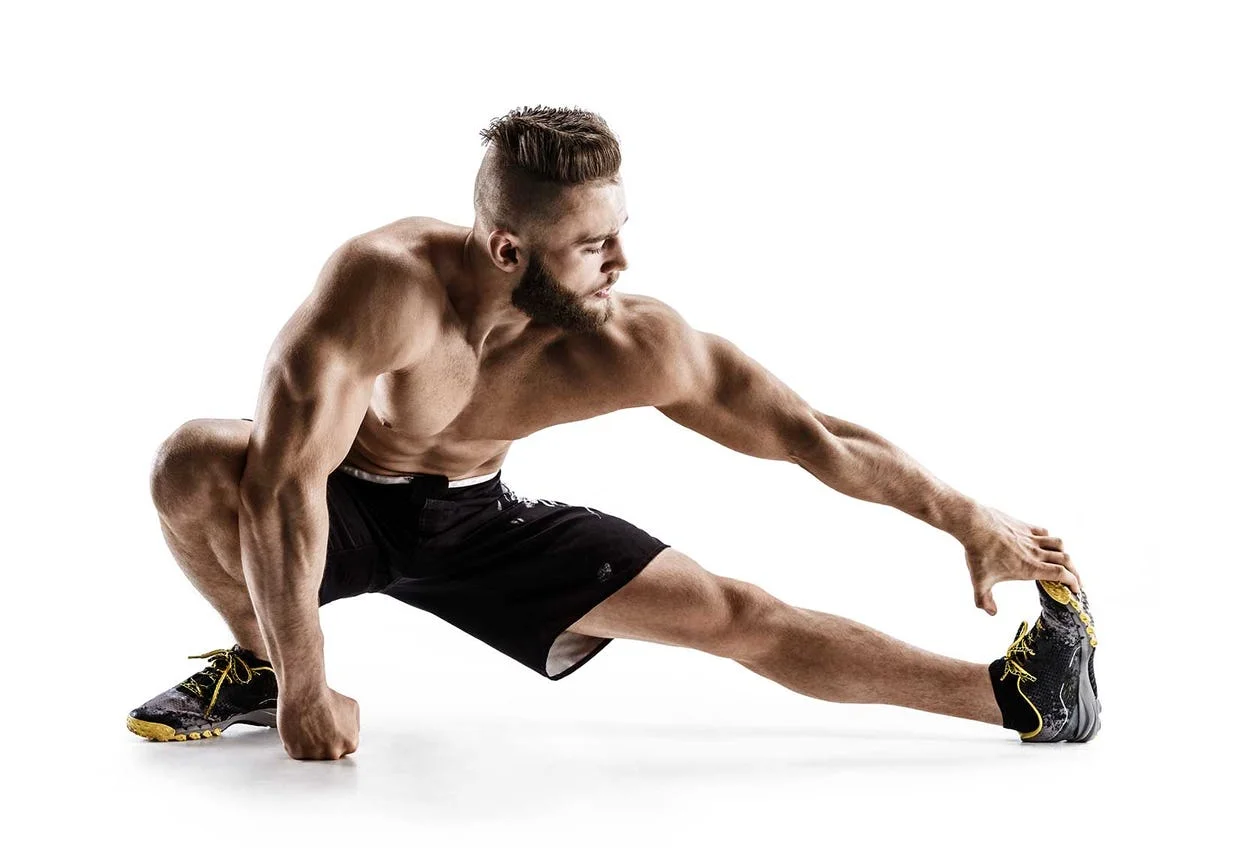Overview
Leg movements rely heavily on the hamstring muscles, which are located at the back of your thigh. Walking, running, as well as cycling require them to flex their knees and extend their hips. Strengthening these muscles is critical for good leg health and injury prevention.
Hamstring exercises. These exercises work the muscles in the back of your thigh, allowing you to gain strength and stability.
To get the most out of your lower-body workout, incorporate some hamstring workouts. This will ensure you’re exercising effectively and maintaining a healthy balance in your routine.
We’ve compiled a list of great hamstring workouts for you below. Some of them need the use of external resistance, such as barbells, dumbbells, and resistance bands, while others simply require your body weight.
- Hamstring exercises are designed to strengthen the hamstrings, a muscle group located on the back of the thigh. Tight hamstrings may result in pain in the lower back, knees, and lower abdominal area.
- Hamstring exercises can be used to improve flexibility, strength, and athletic performance.
The hamstrings are a large group of muscles in the lower body. Three muscles are involved: biceps femoris, semitendinosus, and semimembranosus.
It is situated in the back of the thigh in the leg. - A hamstring muscle is commonly referred to as the opposite group muscle of the quadriceps femoris, but this does not imply that the two muscles do not work together. When you stand, both groups of muscles work together because your knees and hips are extended.
- Daily activities such as running require the use of the entire hamstring muscle. It allows for knee flexion and hip extension control while biking or walking.
- The benefits of hamstring muscle exercise include strengthening the back thigh, increasing muscle power, and improving tone. It primarily focuses on mobility and strength. Stronger hamstring muscles can allow athletes to compete better than others.
- This muscle is used in a variety of sports activities. This helps to boost stamina and speed during sports activities. This muscle’s function is hip extension and knee flexion. When engaging in strenuous activities, it is critical to protect the hamstring muscle.
- When the hamstring is injured, you will initially feel pain in the back of your knee. A hamstring injury produces sharp shooting pain in the back thigh.
- You feel a pop of muscle. Hamstring injuries are most commonly seen in athletes and dancers as a result of sudden stops and starts during activities. When you suffer from a hamstring injury, you must sleep with your knee straight. To prevent this injury, you must strengthen and stretch your hamstring muscles.
- The action of the hamstring muscle is a hip extension and knee flexion; it is critical to keep these muscles loose and flexible. The hamstring stretch will help you avoid strains and muscle tears.
Anatomy
The hamstring complex includes three muscles: the biceps femoris, semimembranosus, and semitendinosus. All true hamstrings are innervated by the tibial, or medial, branch of the sciatic nerve. For these reasons, some experts believe that only the long head of the biceps femoris muscle is part of the hamstring complex; the short head of the biceps femoris starts on the femur and is supplied by a branch attached to the common peroneal nerve.
The biceps femoris, additionally referred to as its lateral hamstring, is one of the more distal (towards the outside of the body) of the three hamstring muscles. The semimembranosus the majority medial (toward the center of the body); the semitendinosus lives in between. The semimembranosus, as well as semitendinosus, are also known as the medial hamstrings. All three muscles help to flex the knee, extend the thigh at the hips, and rotate the leg. When the knee is fully extended, the lateral hamstrings are more active than the medial hamstrings to flexion or hip extension.
Function:
The hamstrings are the muscles responsible for hip extension and knee flexion. The hamstrings are essential for walking’s complex gait cycle, which includes kinetic energy intake as well as knee and hip joint protection.
During the swing phase of walking, the hamstrings slow a tibia’s forward motion. Hamstring contraction has a complex interaction with quadriceps contraction, which is the hamstring’s antagonist muscle.
Health benefits of Hamstring Exercise.
Strengthen the back thigh to improve knee flexion and hip extension.
Improved Athletic Performance:
- Strong hamstrings improve your athletic ability.
- They allow for improved running, jumping, as well as agility.
- Athletes with well-conditioned hamstrings perform better in sports.
Enhanced mobility:
- Flexible hamstrings increase your range of motion.
- Activities such as walking, climbing stairs, as well as bending become easier.
- Reduced hamstring tightness alleviates discomfort during daily movements.
Reduced risk of injury:
- Keeping the hamstrings flexible reduces the possibility of straining or tearing muscle fibers during strenuous physical activities like running.
- Help athletes improve their stamina and speed. They help to keep your joints stable while moving.
- Hamstrings that are well-conditioned are less likely to strain, tear, or sustain other injuries.
Improve flexibility:
- Stretching the hamstring muscles increases flexibility and range of motion in the hip and knee joints.
- Both of these benefits will make it easier for people to complete daily tasks like walking up stairs, climbing stairs, and bending forward.
- Improve or maintain your posture.
Help reduce back pain:
- Tight hamstrings limit pelvic mobility, putting pressure on the lower back.
- It reduces the strain on your lower back while performing various activities.
Other:
- Help to improve blood circulation.
- Reduce muscle fatigue and help lower the risk of injury.
- It improves balance and increases stamina.
- Help to avoid the start of postponed muscle soreness.
- Reduces the risk of sciatica Pain
- Tingling and numbness in the posterior thigh.
- Strong hamstrings allow you to move efficiently, quickly, and effortlessly.
- It helps avoid injuries because the hamstrings stabilize the knee and hip joints.
- Include hamstring exercises in your workout routine to reap these health benefits. Remember to use proper form as well as gradually increase intensity.
What is causing tight hamstrings?
- While it may appear that one nagging issue is making your muscles scream in agony, tight hamstrings are caused by a combination of several factors. But, before we get into why, let’s first understand where these posterior leg muscles are and what functions they perform.
- The lower-body muscles run down the back of your leg, starting from your hip and ending at the back of your knee. This group works together to help you straighten your leg as well as bend your knee.
- Tight hamstrings can be caused by office work, sitting for long periods, or simply not stretching the muscles enough.
- Tight hamstrings may additionally be caused by weaknesses or imbalances in the surrounding muscles, particularly the quadriceps and hip flexors. You can also feel stiffness in the back of your legs after participating in activities that put too much strain on the hamstrings, including running or heavy weightlifting, especially if you don’t warm up or cool down properly with dynamic and static stretching.
What are a few common mistakes to prevent when stretching your hamstrings?
There are a few mistakes to avoid while stretching:
- Bending the knees: If you want a perfect hamstring stretch while sitting, keep your legs extended. If your hamstrings are tight and you need to bend your knees, simply do not stretch as far forward. Improving hamstring flexibility takes time.
- Hunching over the shoulders: Instead of hunching over with your shoulders, try to hinge at the hip level. Imagine reaching up and over the legs while keeping the spine in a normal position. It is preferable to maintain a neutral spine and avoid moving so far forward that you hunch over to touch your toes.
- Bouncing: It can activate the stretch reflex, leading to increased muscle contraction rather than decreased contraction. This can lower the stretch’s effectiveness and increase the risk of injury.
What are some exercises for stretching the hamstring muscles?
- A hamstring is a group of three muscles in the back of the thigh. The semimembranosus, semitendinosus, and biceps femoris muscles cover the hip and knee joints, respectively.
- Sports requiring a lot of running or stop-and-start motion, such as soccer and tennis, can cause hamstring tightening. Like dancing and running.
- Keeping these muscles loose is beneficial. Tight hamstrings cause strain and tears. There is also a difference between injury and tightness. If you experience hamstring pain, consult a doctor before attempting to treat the injury at home.
- There are numerous stretches that you can do to help keep your hamstrings loose. Warm up the muscles before stretching. Try to warm up your muscles by walking or doing another activity.
- People may set a goal of stretching their muscles, including their hamstrings, regularly. Even just a few minutes every everyday stretching can help a person’s general mobility.
- If someone experiences persistent tightness in their hamstrings, they should consult their physiotherapist. Constant tightness in the hamstrings may indicate over-lengthening.
- Simple hamstring stretch
- Hurdler’s Hamstring Stretch
- Standing hamstring stretch (both legs)
- Standing hamstring stretch (one leg).
- Towel Hamstring Stretch
- Standing Forward Bend
- Standing Toe Touch
- Lying Hamstring Stretch
- Lying Hamstring Stretch with Band
- Wall hamstring stretch
- Standing Hamstring Stretch With Chair
- Lunged Hamstring Stretch
1. Simple hamstring stretch
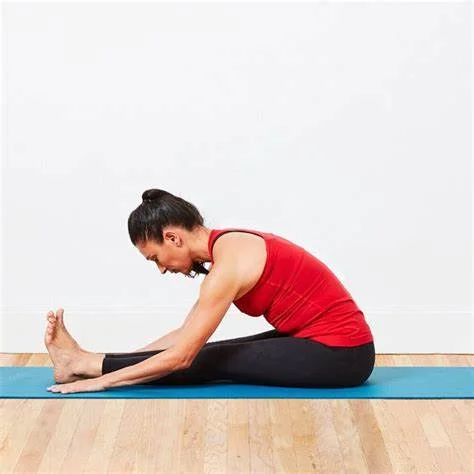
Begin with a simple hamstring stretch. If you suffer from low back pain or sciatica, this exercise may put a strain on your back, so use caution.
- Sit on the floor, both legs straight.
- Reach forward and extend your arms, bending your waist as much as you can without bending your knees.
- Hold this position for 15–30 seconds.
- Relax back into the starting position.
- Repeat three times.
- Stretch until you feel a gentle pull on the back of your thighs. If you experience excessive pain, you should stop the exercise.
2. Hurdler’s Hamstring Stretch
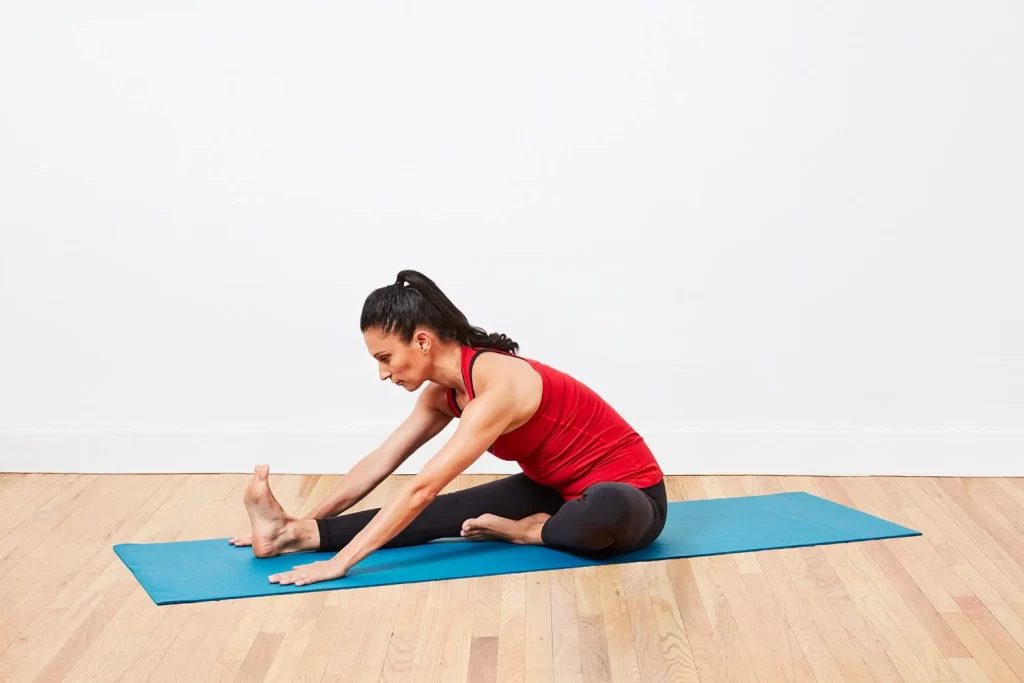
The hurdler hamstring stretch was a simple exercise that may be performed on the floor.
- Sit on the floor, both legs straight.
- Bend the other leg at the knee and place the sole against the opposite inner thigh.
- Extend your arms as well as reach forward over the straight leg, bending at the waist as far as possible.
- Hold this position for ten seconds.
- Relax.
- Repeat for the other leg.
3. Standing hamstring stretch (both legs)
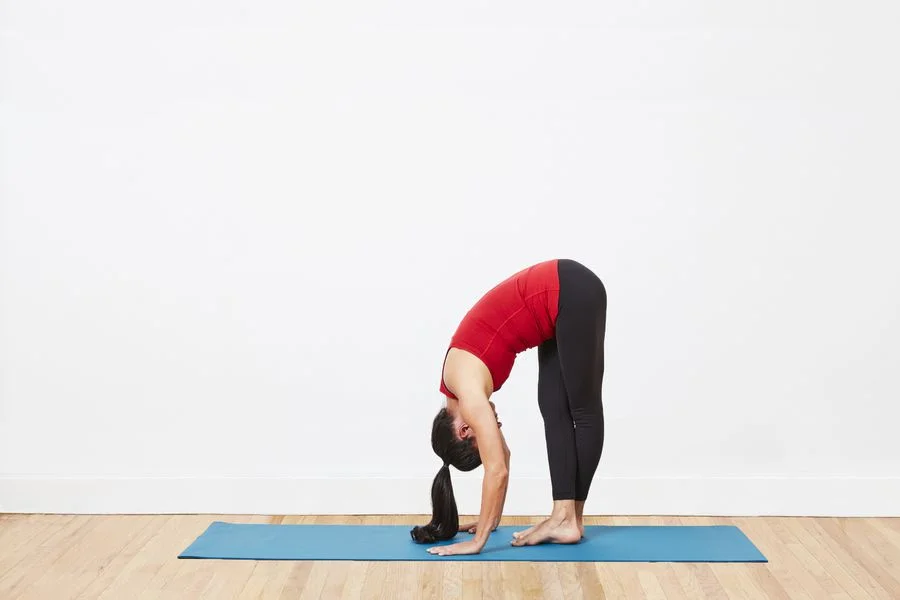
The next hamstring stretch is performed in a standing position, stretching both legs at once.
- Standing, cross the right foot in front of your left.
- Slowly lower the top of your head to your right knee while bending at the waist.
- Keep both knees straight.
- Hold this position for 15–30 seconds.
- Relax.
- Repeat on the opposite side, crossing your foot on the left in front of your right.
4. Standing hamstring stretch (one leg).
The one-legged standing hamstring stretch is one of the most simple stretches. You can do it anywhere—at home, in the office, or outside.
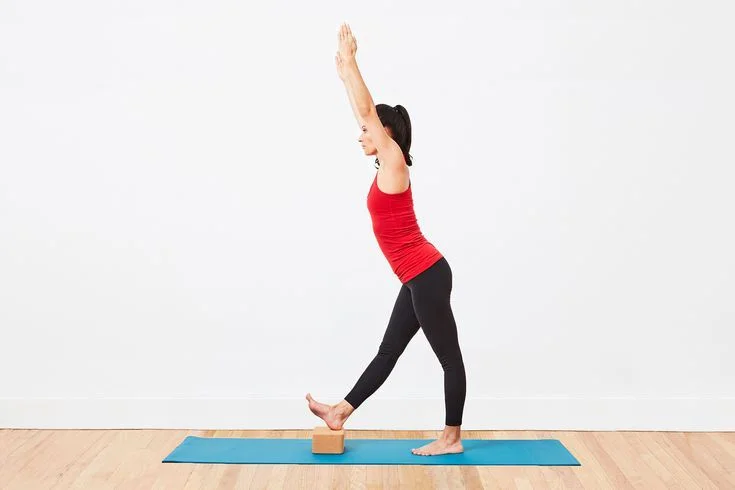
- Stand upright with a single heel resting on a small stand of books, a yoga block, or as a stool. If you’re outside, you may use the curb, but keep an eye out for cars.
- Keep your knees straight.
- Reach both arms up so that they are roughly level with your ears. Reaching your arms up, rather than down toward your foot, will help keep your back straight.
- Bend slightly forward from the hips.
- Hold the stretch for 15 to 30 seconds, then repeat three times.
- Repeat for the other leg.
5. Towel Hamstring Stretch
Most people have towels for performing towel stretches, but you can also use a strap or belt.
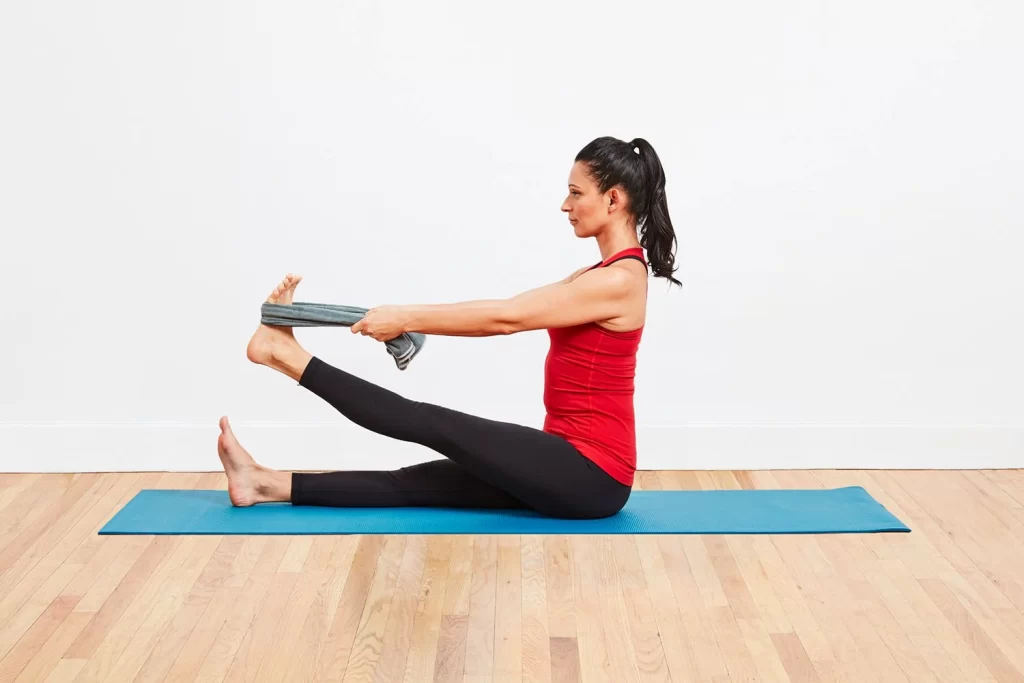
- Lie back on the floor.
- Loop a long bath towel around your foot, holding the ends in both hands.
- Slowly pull on the towel to lift the straight leg. Check your ability to keep your knee straight. The leg without the towel should be flat on the ground.
- Bring your leg up until you feel a stretch behind your thighs. You might experience a stretch in your calves. This is normal.
- Hold for 15-30 seconds, then relax.
- Repeat three or five times on each leg.
6. Standing Forward Bend
The standing forward bend is a simple hamstring stretch that uses gravity to deepen the stretch. If your lower back is sore, proceed with caution or try a different stretch.
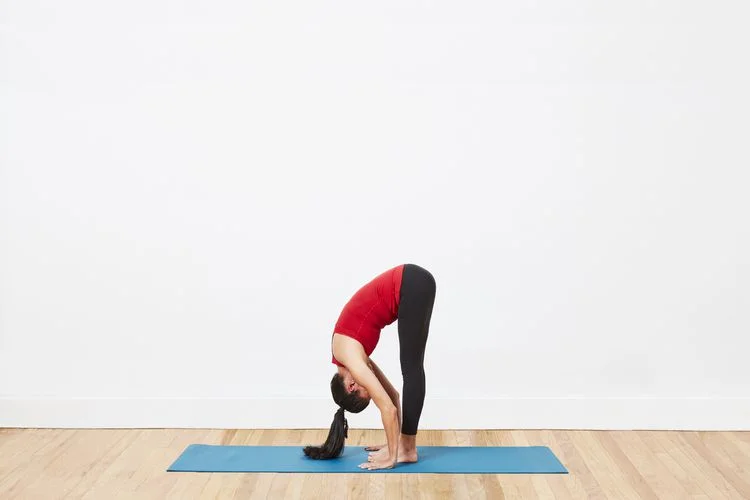
- Stand up straight, arms overhead.
- Fold forward from the hips and reach your hands to the floor. Your hips should be stacked above your ankles. The goal during this stretch is to avoid touching your toes.
- Consider your quadriceps, the muscles in the front of your thighs. Engage your quads to deepen the hamstring stretch.
- Hold for 15–30 seconds, then relax
- Go back to the upper body to the standing position.
7. Standing Toe Touch
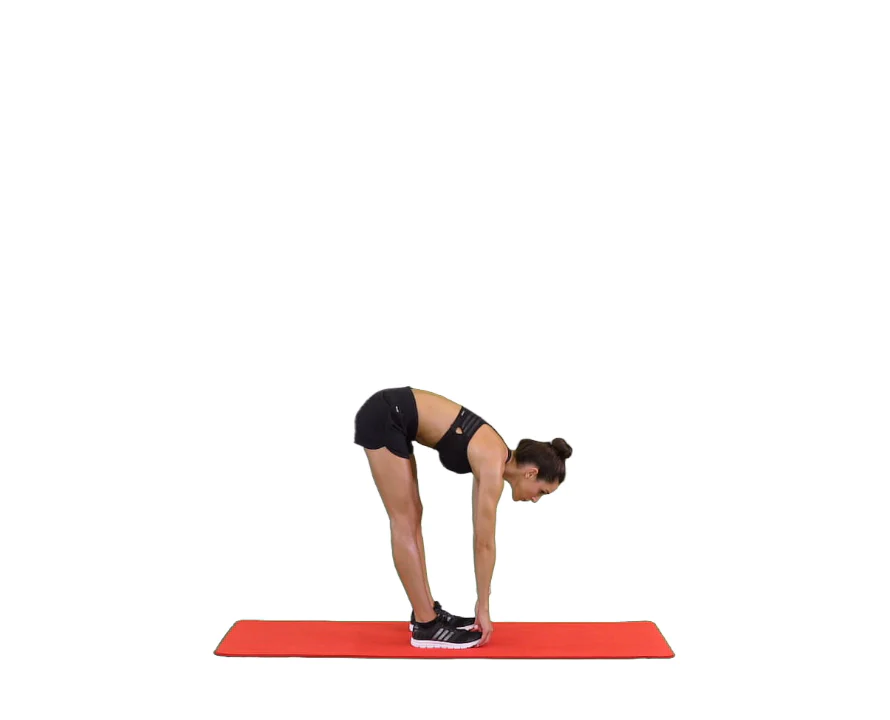
- To stretch your hamstrings, touch your toes.
- Although standing, turn forward at the hips as well as try to reach your toes with your fingers.
Hold this position for thirty seconds. - Repeat three times.
- Here are some suggestions to make this more secure and efficient.
- Do not bounce. Bouncing activates the stretch reflex. This can lead to greater muscle contraction, not less.
- Lift the sitting bones to the ceiling. This lengthens the hamstring muscles.
- Check that your hips are directly above your feet. Your buttocks shouldn’t be behind your feet. This mistake reduces the stretch’s effectiveness.
- If your abdominal muscles are weak, consider using a table or another surface to help you get back to standing.
- A general rule of thumb for safety: only go as far as you can without experiencing back pain or feeling insecure.
8. Lying Hamstring Stretch
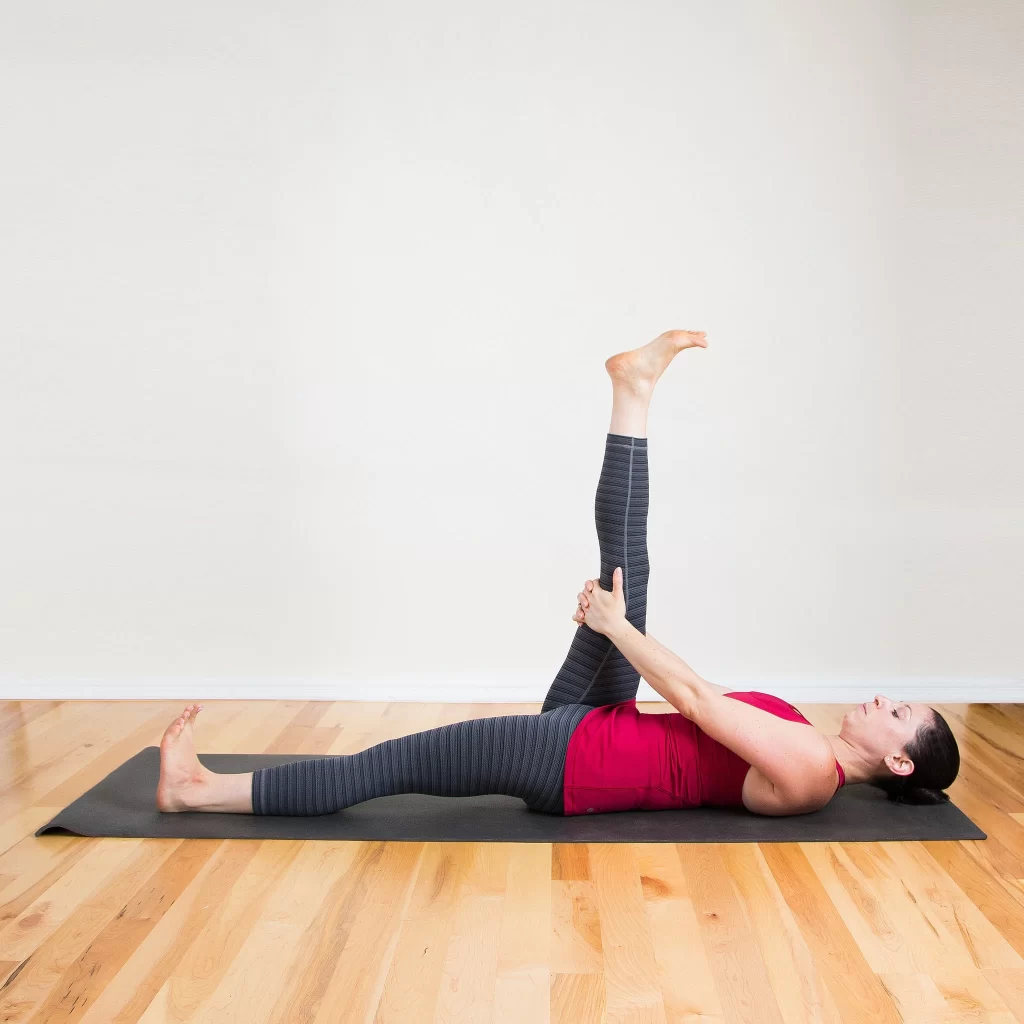
A woman stretches her hamstrings while lying on her back, grasping the ankle of a straight leg.
This exercise is ideal for beginners who have difficulty touching their toes or suffer from hamstring stiffness.
Put a belt or belt that is adjustable around the bottom of your foot.
If you are unable to reach your toes, use the strap to pull your leg towards your head.
- You may also grab the part of your leg over your foot rather than your toes.
- Bend the opposite leg to stabilize and align your trunk while stretching.
- Hold for 30 seconds.
- Gradually lower your leg.
- Repeat for the other leg.
- Repeat this exercise two to three times for each leg.
9. Lying Hamstring Stretch with Band
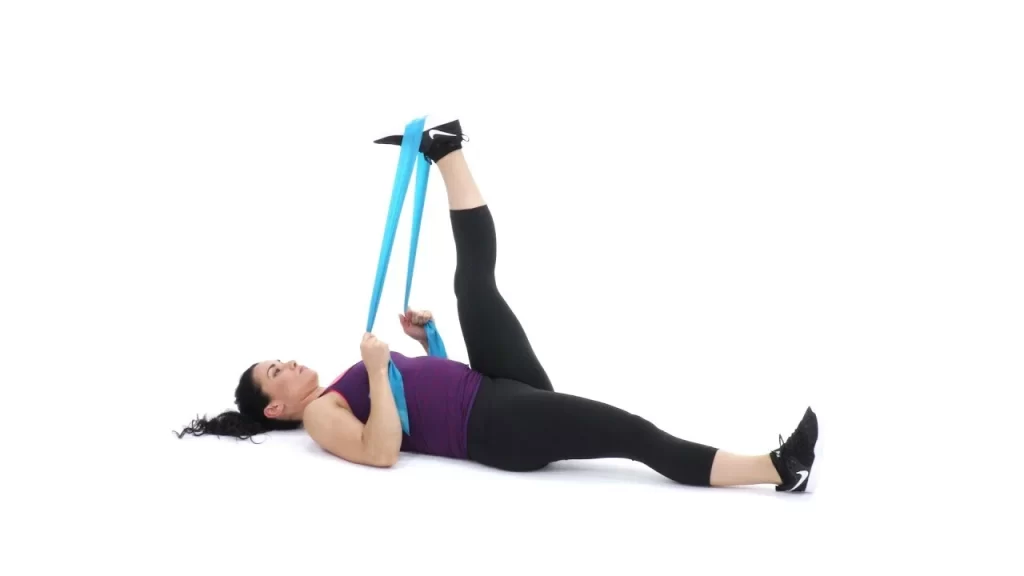
Reclined Big Toe Yoga Pose. This intermediate stretch uses an exercise band, but it can also be performed without one.
- Lie on your back.
- Tighten the stomach muscles as well as lift your leg, either straight or slightly bent.
- Pull gently on the band to stretch your hamstrings.
- Hold for 10-30 seconds.
- Release the band as well as gradually lower your leg.
- Repeat for the other leg.
- Repeat this exercise two or three times for each leg.
10. Wall hamstring stretch
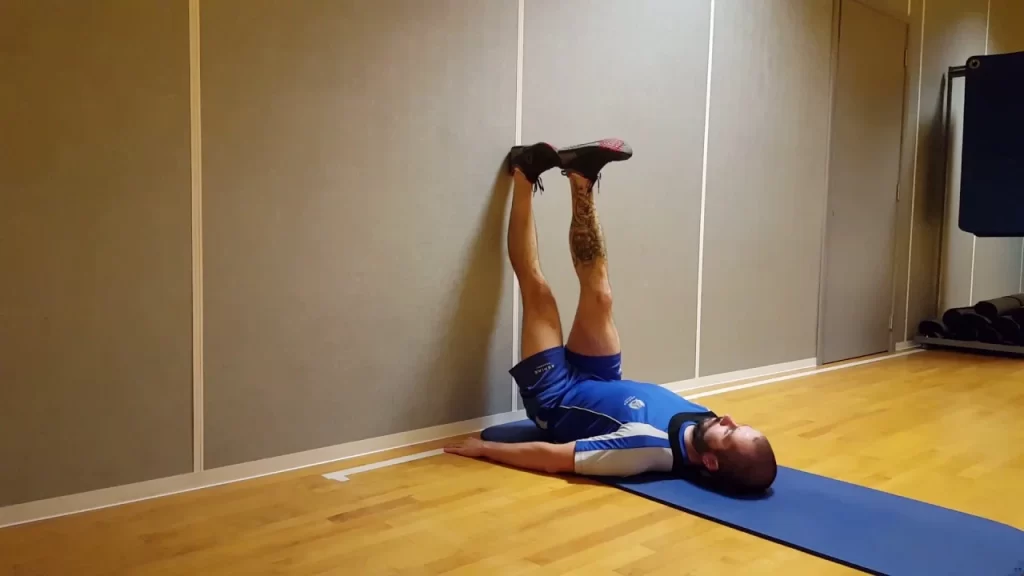
- This stretch can be done in a doorway or along the edge of a piece of furniture, such as a sofa.
- Raise the opposite leg as well as rest it against the wall, slightly bent.
- Hold for thirty seconds.
- Switch legs as well as repeat.
- Repeat the workout at least three times for each of your legs.
11. Standing Hamstring Stretch With Chair
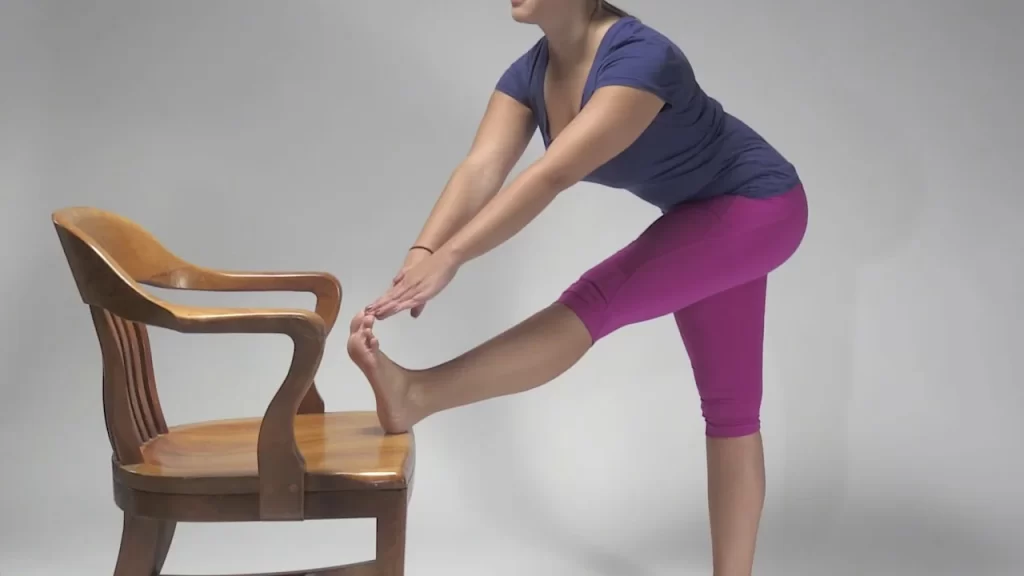
- Place the sole or ankle of one leg upon something about waist height or slightly lower.
- Bend at the hips and bring the upper portion of your trunk to your thigh.
- Hold to 30 seconds.
- Switch legs as well as repeat.
- Repeat this exercise up to three times for each leg.
- For the best results, keep your spine straight. A straight back will also help protect your spine.
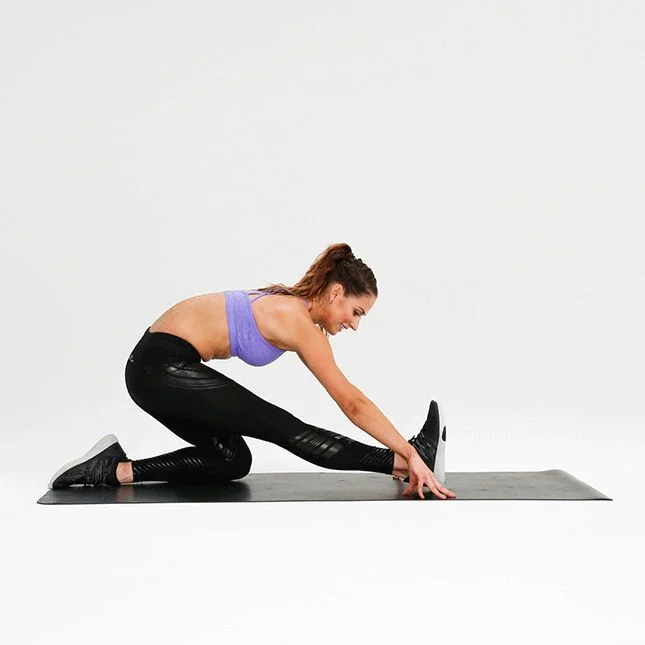
12. Lunged Hamstring Stretch
- A female athlete performs an advanced hamstring stretch as squatting.
- Ammentorp
- If the standing hamstring stretch with a chair isn’t difficult enough, try it while in a one-legged squat.
Safety & Precautions for Hamstring Stretch
- A general flexibility program can help your hamstrings move more efficiently. Before beginning this or any other exercise program, speak with a healthcare professional or a physical therapist to make sure that the exercise is secure and beneficial for you.
- Static versus Dynamic Stretches: The timing of your flexibility routine decides whether you should do static or dynamic stretches.
- Static stretches work best after an exercise while the muscles are still warm. They include holding a position for a few seconds.
- Dynamic stretches use controlled movements to warm up the body and prepare the muscles for more strenuous activity.
- The following instructions are for static stretches. To make them dynamic, spend 60 to 90 seconds moving in and out of each position with steady, controlled movement. If you experience any pain and abnormal sensations in the hip, thigh, or lower leg, evacuate and seek medical attention.
The Role of Hamstring Strengthening Exercises
- Hamstring strengthening exercises have numerous benefits for your general health and mobility. Strong hamstrings allow your knees, legs, and hips to function smoothly while safeguarding against injury.
- However, the most important reason to perform hamstring exercises or any other strength training is how they make you feel.
- Exercise is a proven mood booster, helping you improve your outlook, reduce anxiety, as well as feel better about life as well as yourself. That’s why, at Blink Fitness, we focus on how exercise makes you feel rather than how you look.
- Strengthening exercises should be performed to gradually increase the force transmitted through the tendon. This is critical to preventing injury from recurring. It is not advisable to immediately resume normal training levels once you are pain-free.
- Strengthening exercises can begin as soon as they can be performed without discomfort. This could occur after the first 48 hours or up to a week before strengthening can begin.
- There may be a gradual progression. When you can tolerate the easy exercises without pain during, after, or the next day, progress to a more difficult exercise.
Strengthening exercises ought to continue long after you feel the injury has healed.
What are some Hamstring muscle-strengthening exercises?
- Sumo Squat
- Kettlebell Swing
- Single Leg Deadlift
- Basic Bridge
- Single-Leg Bridge
- Lying Leg Curl
- Leg press on the ball.
- Reverse Plank
- Traditional Squats
- Romanian deadlift
- Weighted Glute Bridge
- Marching Glute Bridge
- Barbell Hip Thrust
1. Sumo Squat
Try including the sumo squat in your hamstring exercise routine to target your inner thighs, adductor muscles, and hamstrings. The sumo squat provides the same advantages as the traditional squat but increases activation of the inner thighs as well as hamstrings. You can do this move with or without the weights.
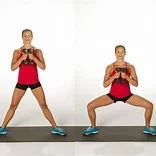
Step-by-step instructions.
- Stand with feet slightly wider compared to. Point your toes approximately 45 degrees outwards. Your hips will rotate outwards.
- Hold your arms extended in front of you, shoulder height. If you’re using weight, keep the dumbbells securely at your shoulders in a goblet position in front of your chest.
- Take a deep breath, participate in your abdominal muscles, and push your thighs back to lower into a squat position.
- Stop at the bottom, exhale, and return to a standing position. Keep the weight evenly distributed in the heel and midfoot.
- Do 12 to 15 repetitions.
- You may render this move more difficult by squatting lower, or easier by squatting shorter distances.
2. Kettlebell Swing
An athletic man performs a kettlebell move exercise at the gym.
If you’re looking for an exercise that increases cardio endurance, burns calories, as well as targets multiple muscle groups, try swinging. The kettlebell swing works all of the lower body muscles, but it specifically activates the hamstrings.
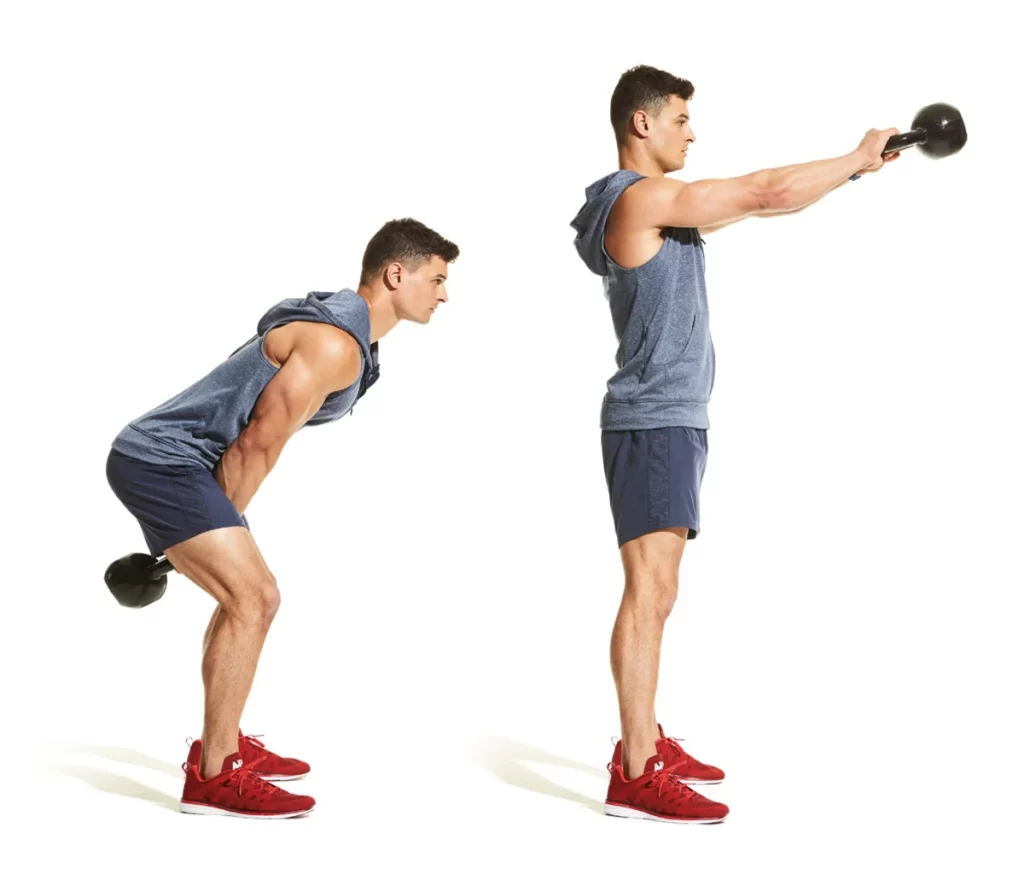
Step-by-step instructions.
- Hold onto the handles of the kettlebell as you place it slightly in front of you. Maintain your shoulders back and your head down.
- Stand with your feet slightly wider compared to hip distance apart and your toes angled out slightly.
- Maintain a straight spine with your shoulders, slightly bend your knees, send your hips backward, and tip your torso as you pick up the kettlebell in both hands. This is NOT a squat. It is a hip hinge, so avoid significant knee flexion.
- With the kettlebell in your hands, roll your shoulders back, tighten your core, and push your glutes and hamstrings to begin the exercise.
- Swing the kettlebell upward in front of your chest. Repeat by lowering the kettlebell and swinging through your legs.
- Perform 15 to 20 repetitions or for a set amount of time.
- Make sure you’re performing a hip hinge, not a squat. The hinge movement enables you to target the hamstrings as well as the glutes.
- We tried, tested, as well as reviewed the top kettlebells. If you are in the market for kettlebells, consider which option is best for you.
3. Single Leg Deadlift
The single-leg deadlift works the hamstring muscles in the standing leg. Choose a kettlebell as well as a dumbbell that is small enough to maintain correct posture but heavy enough to get your hamstrings working.
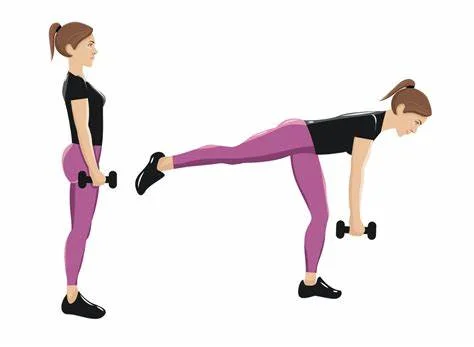
Step-by-step instructions.
- Stand on your right leg, with a soft knee bend. Hold a kettlebell with your right hand. The left foot will rise off the ground.
- Tip your body forward by hingeing at the hips and shifting your weight to the ground. Keep your chest up. The leg on the left will be erect behind you. Stretch as far as you’re able until you feel tension in your right hamstring.
- Stand up straight, pressing your glutes, then come back to the starting position.
- Finish all reps on the opposite leg before switching to the left leg.
- Perform 8-10 repetitions on each leg.
- If you’re new to this exercise, try it without weights before adding a kettlebell and dumbbell. It takes time to execute this move properly. When in doubt, consult a personal trainer and physical therapist.
4. Basic Bridge
The basic bridge exercise focuses on strengthening the glute and hamstring muscles.3 Because it is a beginner exercise, it is suitable for all fitness levels.
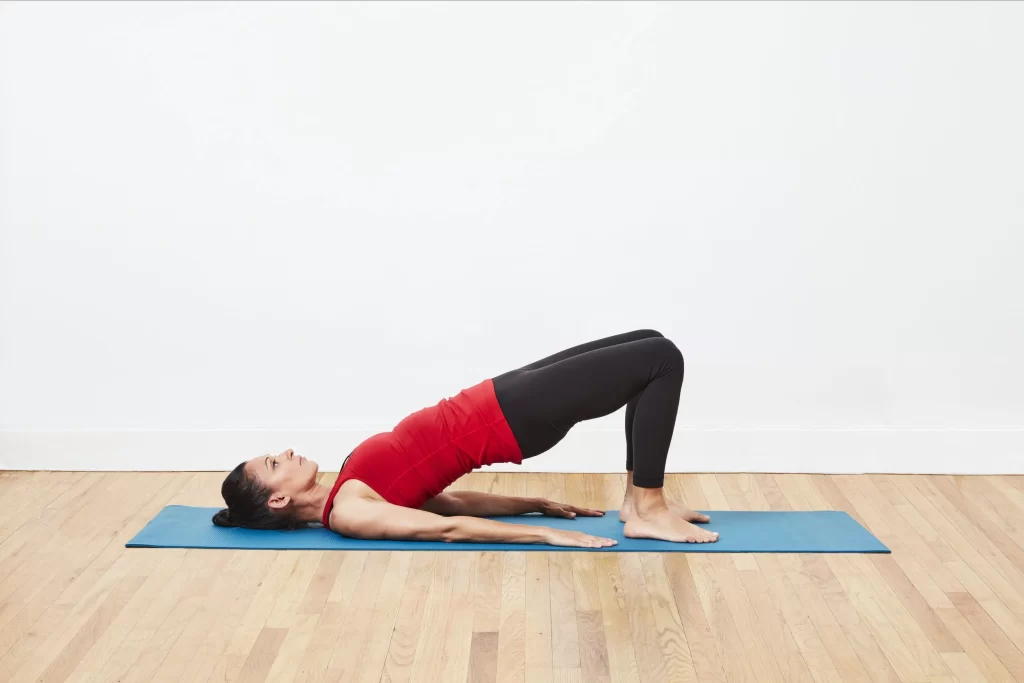
Step-by-step instructions.
- Put an exercise mat on the floor. Lie on your back, knees bent, feet flat on the floor about a foot from your buttocks. Arms should be at your sides.
- Contract your abdominal muscles and glutes, press your heels into the floor, and raise your hips off the ground until your body is straight to shoulders to knees. Concentrate on contracting the hamstrings.
- Pause in this position for 10-20 seconds.
- decrease to the starting position as well as repeat.
Do ten repetitions. - Avoid the bridge if getting on the floor hurts or is unsafe because of a medical condition.
5. Single-Leg Bridge
The single-leg bridge is an alteration of the standard bridge. Raising one leg when in the bridge position isolates the hamstrings as well as the gluteus muscles.
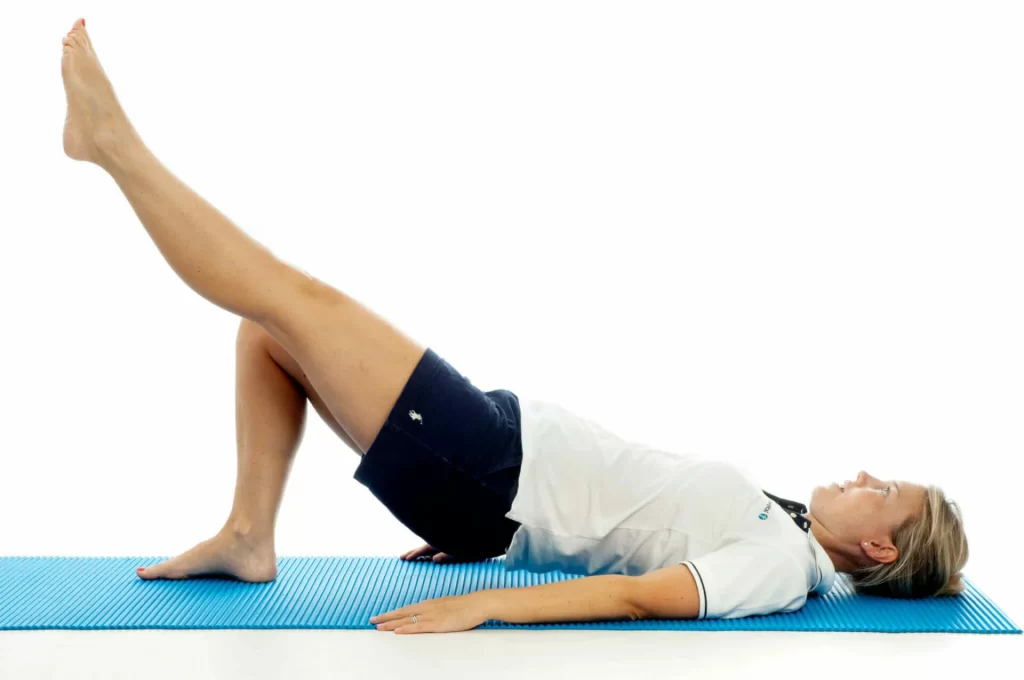
Step-by-step instructions.
- Put an exercise mat on the floor. Lie on your back, knees bent, feet flat on the floor about a foot from your buttocks. Arms should be at your sides.
- Contract the muscles of your abdomen and glutes, press your heels into the floor, and raise your hips off the ground until your body is erect from shoulders to knees. Concentrate on contracting the hamstrings.
- Raise and improve your left leg, maintaining your pelvis elevated and level.
- Wait a few seconds before going back your the bottom to the floor. Keep your left leg raised as well as extended.
- Lower your starting position as well as repeat with the left leg raised before switching to the right leg.
Perform 10 repetitions upon each leg. - For a challenge, attempt to maintain the position for 20 to 30 seconds before going back to the floor and repeating the motion.
6. Lying Leg Curl
The lying leg curl is an isolated exercise that works the hamstrings.4 This move requires the use of a leg curl machine. Most gyms have supine machines. Some places also have leg curl machines that can be used standing or seated.
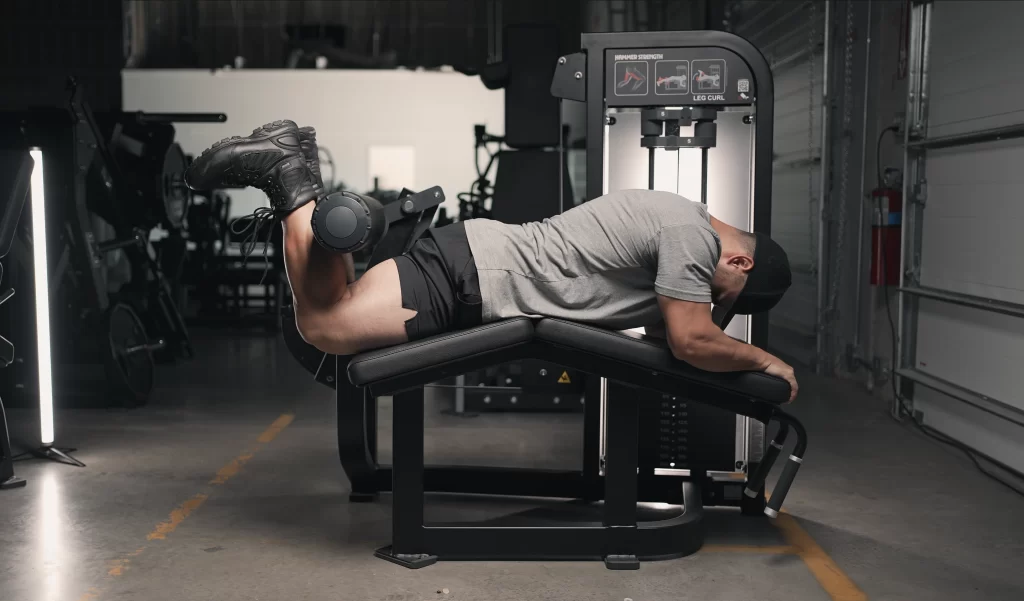
Step-by-step instructions.
- Change the roller pad so that it is above the heels. The machine’s instructions should include pictures showing this step.
- Lie on your stomach, with the roller pad resting against your lower calves. Make sure your legs are completely stretched. Hold the handles on either side of the equipment.
- Lift your feet and maintain your hips on the bench. Flex your knees as well as pull the ankles towards the glutes.
- Pause for a few seconds before slowly lowering the leg to the position from which you began.
Do 10 to 15 reps. - Select a light enough weight to maintain proper form. If the hips are coming off the bench and curling, lower the weight.
7. Leg press on the ball.
A leg press upon an exercise ball works the lower body while improving stability and core power. If possible, make your move on a non-carpeted floor.
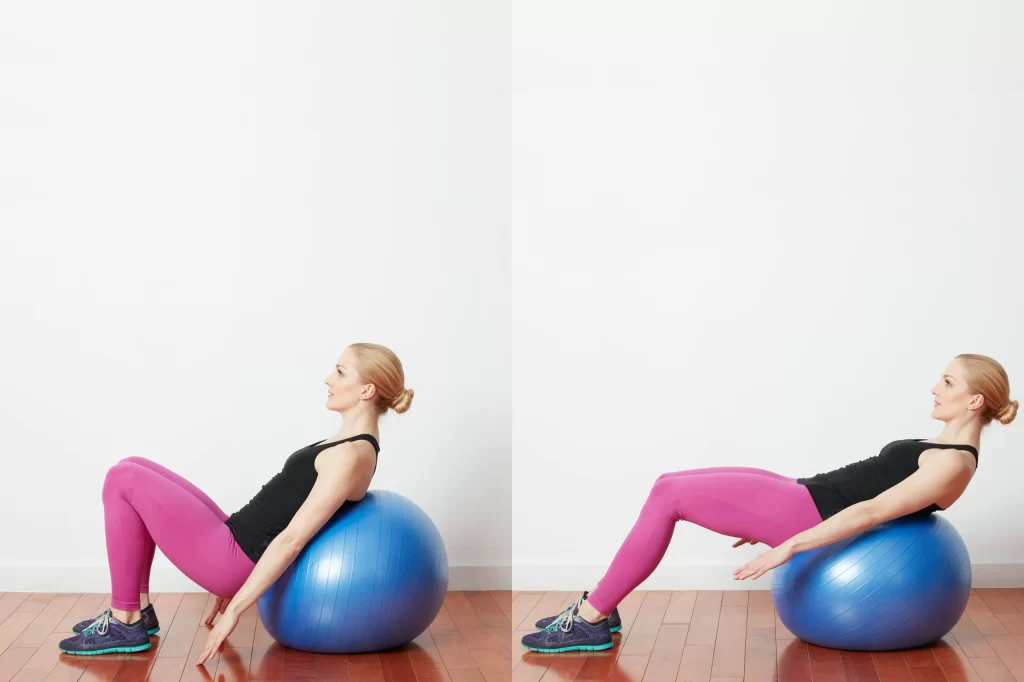
Step-by-step instructions.
- Sit on a big exercise ball.
- Walk with your feet out up until your body forms an incline on the ball. Your shoulders and head will be off the ball. Maintain your natural neck position while not looking up or down. Arms will be by your sides.
- Bend your knees as if you’re going to squat. Following that, press through the heels to get back to the starting position while contracting the hamstrings.
- Do 10 to 15 reps.
- Maintain your weight on the heels instead of the toes. When you return to the starting position, tighten your hamstrings.
8. Reverse Plank
The reverse plank is an intermediate hamstring exercise that benefits the core, glutes, hamstrings, and upper body.5 Include the reverse plank in a core workout or incorporate it into leg day.
Step-by-step instructions.
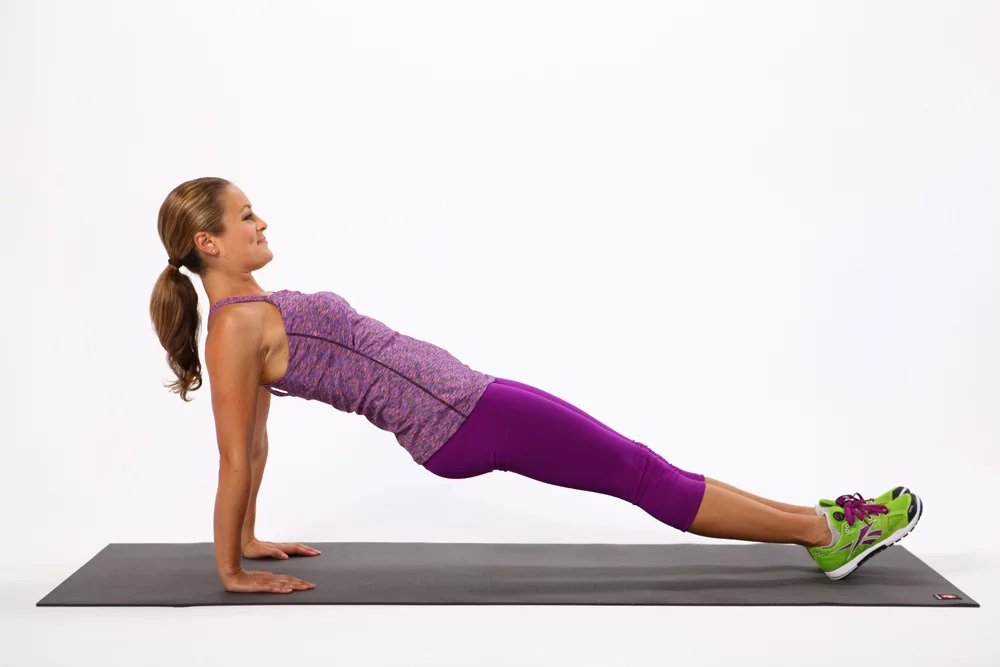
- Put an exercise mat on the floor.
- Position your hands just behind you, palms down, fingers spread wide. Each hand ought to be outside your hips but aligned with your shoulders.
- Lift your hips as well as your upper body toward the ceiling while pressing your hands together.
- Our bodies should be erect from head to heels. Look up to the ceiling.
Contract your core, glutes, as well as hamstrings, then hold the pose for 15 to 30 seconds.
Return to the position where you started. - Do 5-10 repetitions.
- To increase hamstring tension, add a toe tap. Bend the right knee while bringing your toes towards your glutes. Give a toe tap. Extend your leg as well as switch to the left leg. Repeat.
9. Traditional Squats
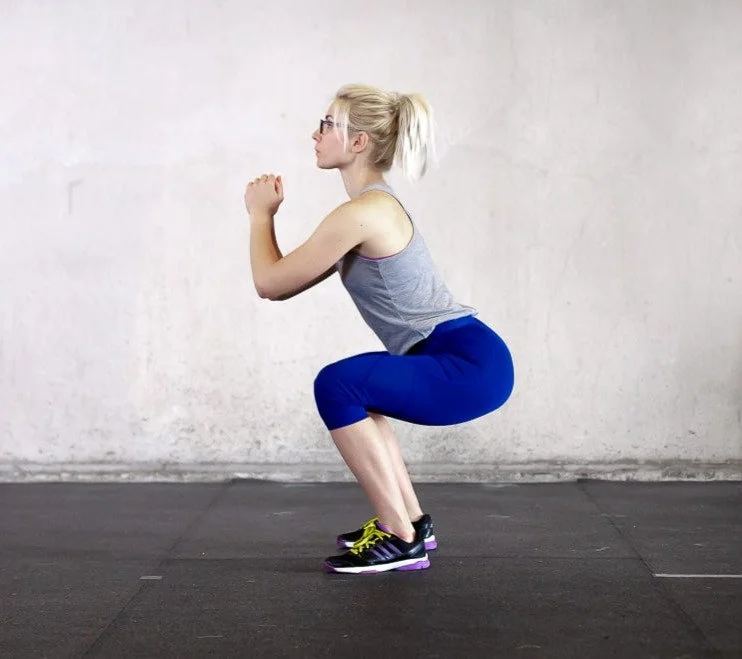
The squat, which targets the glutes, quads, hamstrings, and calves, is essential to any lower-body workout routine.
Step-by-step instructions.
- Stand with feet slightly wider than shoulder-width apart. If you’re using weight, grasp a dumbbell in each hand while you keep your arms at your sides, or stand in a goblet squat position.
- Squat down with your arms raised in front, using only your body weight.
- Hold your head upwards and look straight ahead.
10. Romanian deadlift
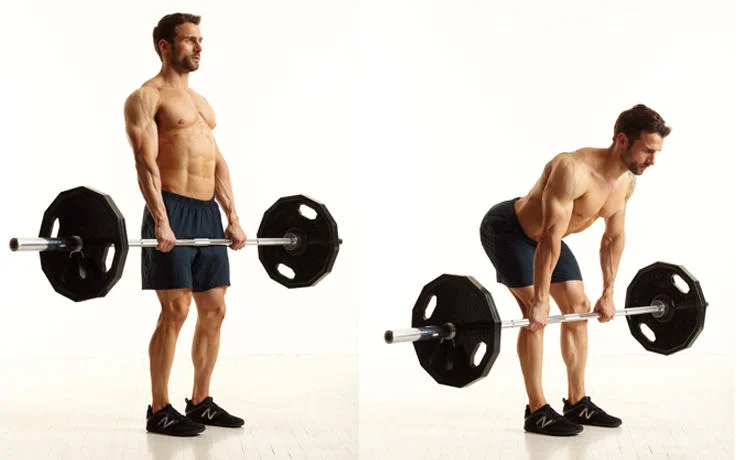
- Hold a dumbbell in each hand as you stand with your feet hip-width apart, knees slightly bent, and arms at your sides near the front of your quads. This is where everything starts.
- Push your buttocks back, hunching ahead at the hips while bending your knees. Slowly lower the weight along your shins, keeping your back flat. Your torso ought to be nearly parallel to the ground.
- Push through the heels to get up straight and return to the starting position with an engaged core. Pull with the weight near your shins.
- Take a moment and press your buttocks at the top. That’s one rep.
11. Weighted Glute Bridge
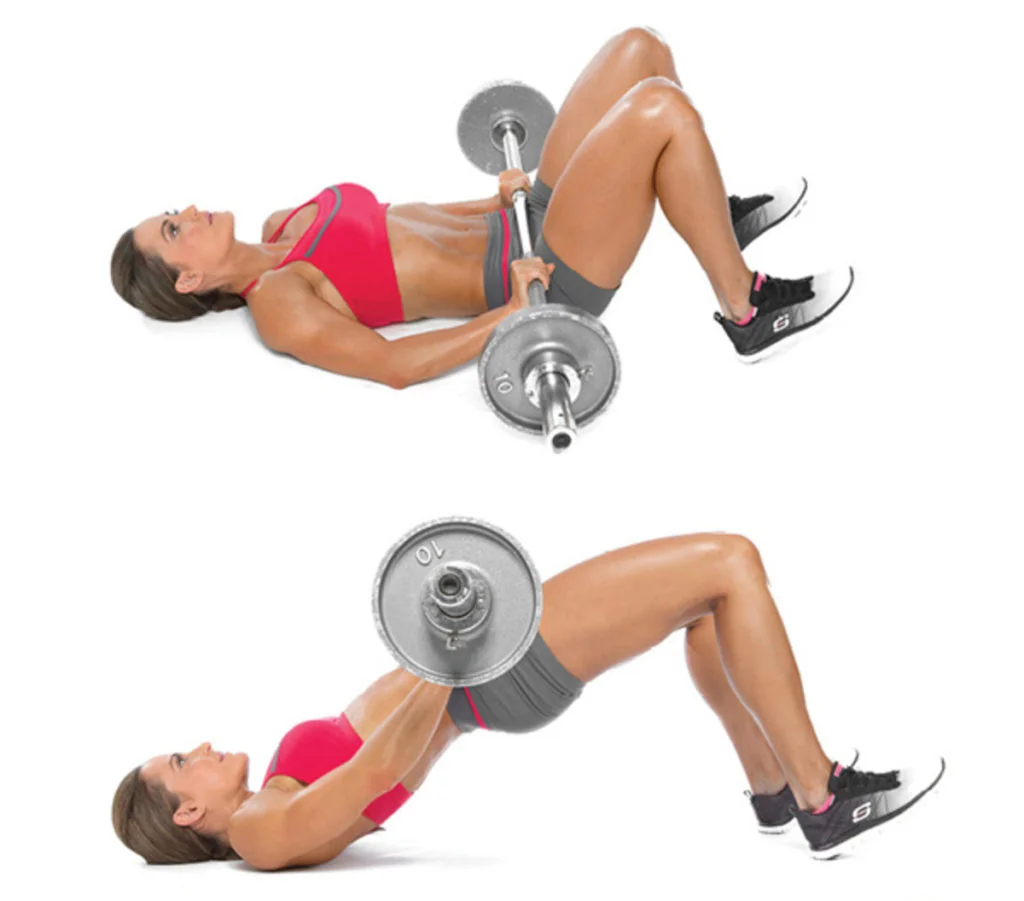
- Place your toes with your hips on the floor, knees bent. Each hand ought to be holding a dumbbell positioned directly beneath the bones of the hip. This is where everything starts.
- Lift your hips a few inches off the ground, using your glutes, core, and heels, until your body forms a straight line from the top of your shoulders to your knees.
- After a brief period of holding, gently lower your hips to the starting position. That’s one rep.
Good morning. - Hold your hands to your ears and stand with your feet hip-width apart. To increase the difficulty, support a weighted bar or just a barbell on your back.
- Fold your body forward, keeping your knees slightly bent, pushing your buttocks backward while hinging forward at the hips.
- Stop when your torso is slightly above perpendicular to the ground.
- As you raise your torso back to the starting position, push your hips forward. At the top, press your glutes. That’s one rep.
12. Marching Glute Bridge
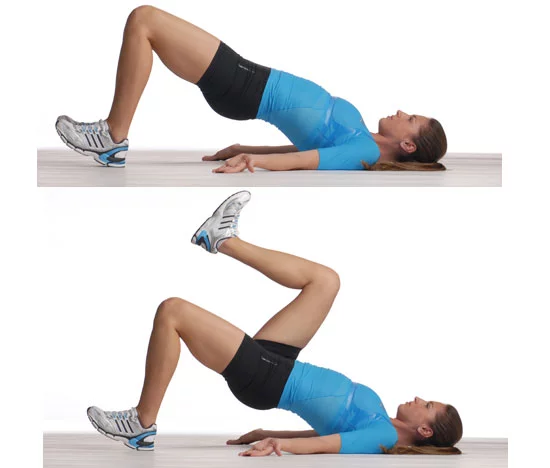
- Lie face up, feet hip-width apart as well as knees bent.
- Check that the back area is tightly compressed to the floor. Lift your hips while keeping this participated stance, squeezing your glutes at the top. Pause here.
- Raise your right foot away from the ground, bringing your knees to your chest and stopping when your right hip is about 90 degrees away from your left.
- Place your foot again on the ground, then lift the other foot off the ground and repeat with the other foot.
- Keep your hips raised as you march, switching feet between steps.
When should you avoid hamstring strengthening exercises?
- If they felt pain while exercising.
- If you’ve recently had any surgery.
- If you have a balance problem.
- Recent knee injury.
- Recent hip injury.
- If you feel your hamstring muscles are overstretched.
- If the doctor advised you to rest
What precautions should I take during exercise?
- Always perform a proper warm-up before rain or competition.
- Stretch your hamstring muscles before and after training. Stretch every day, whether you’re training or not.
- Strengthen the muscles to meet the demands placed on them. Eccentric strengthening is especially important.
- Get regular sports massages to keep your muscles and tendons in good condition.
- Avoid performing a lot of accelerating/decelerating runs or hill workouts.
There is some yoga to strengthen & Stretch the hamstring muscles:
Here are five of my favorite exercises for strengthening the hamstring muscle.
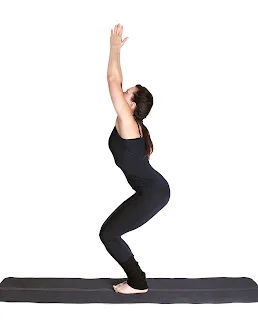
1. Chair-pose
- You must stand with your hips and feet apart.
- Then bend both knees until the thigh is parallel to the ground, and imagine yourself sitting in a chair.
- The spine might be straight. Maintain body weight on heels.
- Place both hands in a prayer position at chest level or raise them above the head for 5-10 seconds.
- Then lower the hand you need to stand up.
2. Crescent Knee Lifts
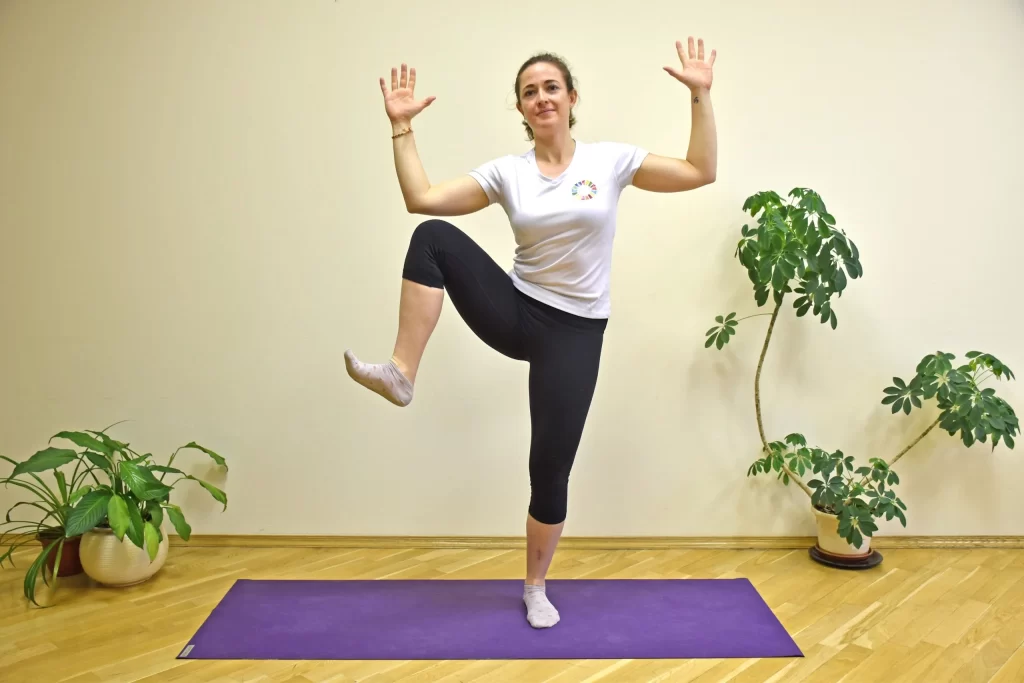
- To perform this pose, stand and extend your right foot approximately 3 feet backward.
- To activate the leg, you must maintain contact with your right toes and reach through the heels.
- Bend your left knee and push it up to 90 degrees.
- You can either place your hands in a prayer position at chest level or extend your arm above your head Before you exhale, raise or lower your right foot. this position for 3–4 seconds.
- Now, take the left leg back and repeat the movement. Repeat 5–10 times on each side.
3. Triangle pose.
Before you exhale, raise or lower your right foot.
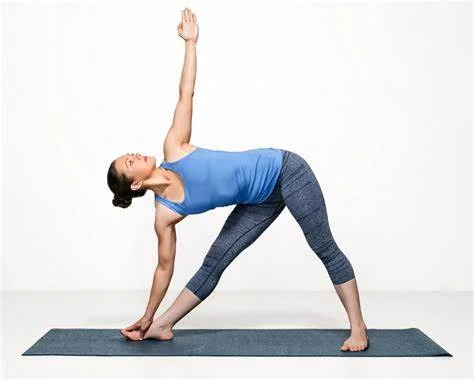
- Set you in the same position as in the Crescent pose.
- Put the left foot flat upon the ground, toes pointing to the left-hand corner of the mat.
Turn your trunk to face the opposite side wall. - Stretch both arms towards the front and back walls.
- The head turns towards the front of the mat.
- Straighten the right leg, breathe in, and reach as far forward as you can with the right hand.
- When you can’t reach any further, breathe out and lower your hand to your mat, pulling at the waist.
- Reach your left hand regarding the ceiling and look up at your fingers.
- You can also elevate the arms above your head, which requires even more core and leg strength.
4. Warrior III
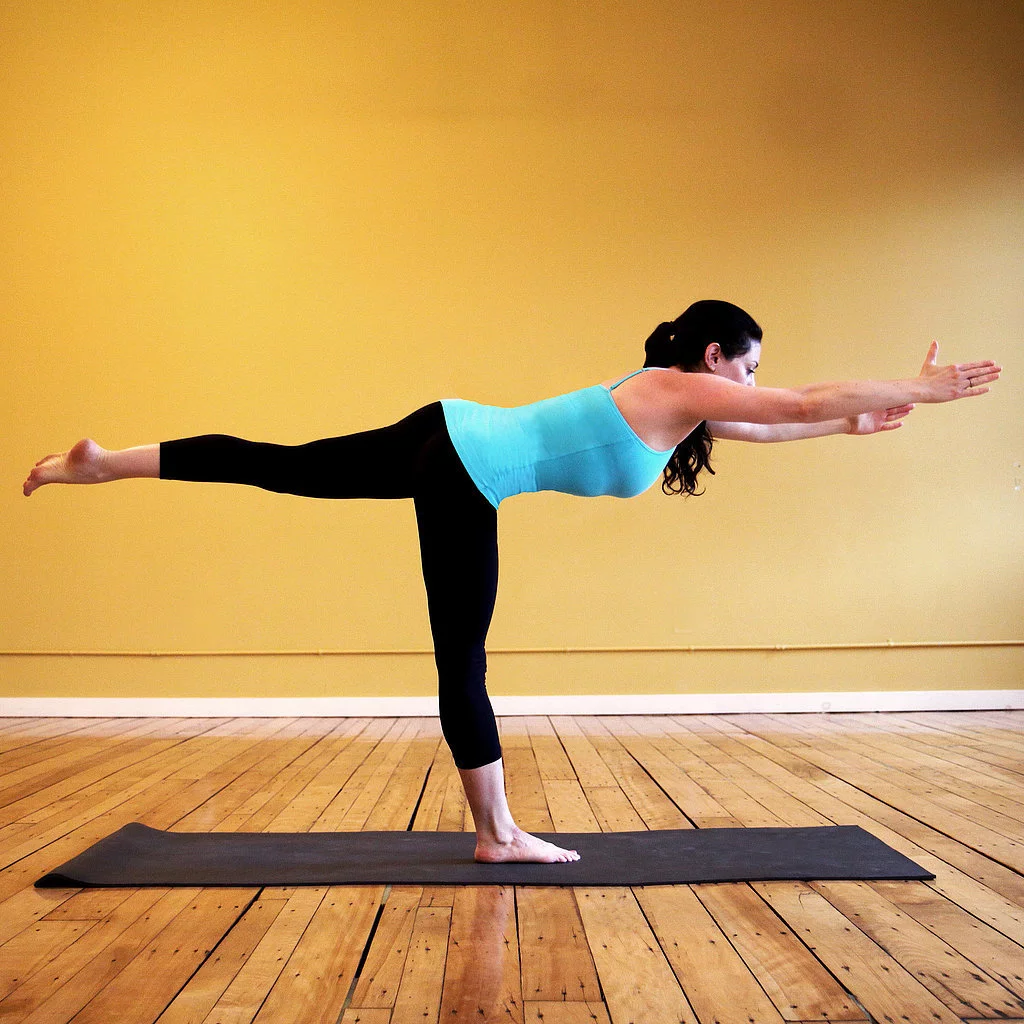
- It would be best if you first took a Crescent Pose.
- Breathe out and bend the right knee; on the inhale, push through the foot and get up on the erect left leg.
- Flex your right foot and push through it, as if you were standing on the wall closest to you.
- You can also keep both arms extended towards the wall in front of you or bring them into a prayer position.
- If you want to combine the Warrior III pose and Crescent Knee Lifts, breathe in the Warrior III pose, then float back down in a crescent pose, breathe out and touch the knee against the floor, and breathe in again into the Warrior All pose.
5. Bow pose.
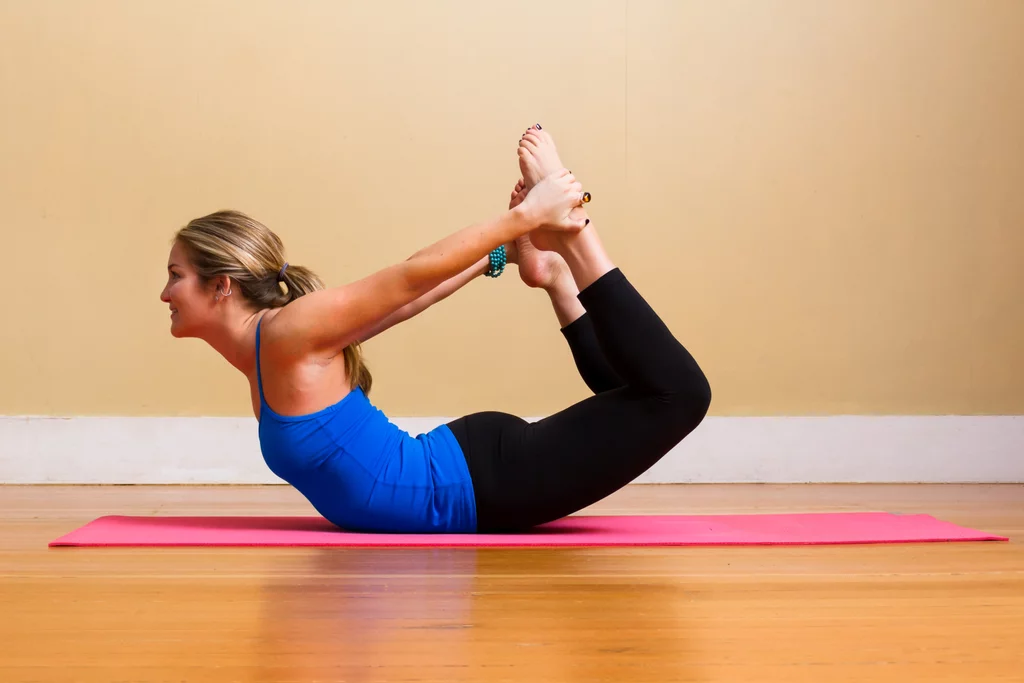
- For this, you must lie on your stomach. Your hip and feet’s distance apart
Bend at the knees and reach back with your hands to grab the tops of your feet while keeping your feet hip-distance apart. - Inhale and push your feet into your hands to pull yourself up.
- Continue to push with your feet and pull with your hands.
- Protect the back by engaging the core and hugging the center of the abdomen to the spine.
- So, while you may want to touch your nose to your knee, remember to balance your body by incorporating hamstring strengthening exercises into your stretches.
- Do not overstretch the body to meet an idealized standard to complete the pose. By incorporating the above simple exercises into your weekly fitness routine, you can increase your hamstring strength and keep these vital muscles happy and healthy.
- Remember that we are always striving to maintain balance in yoga poses. To keep our bodies properly supported on and off yoga mats, we must be stronger and more flexible.
6. Purvottanasana (upward plank pose)
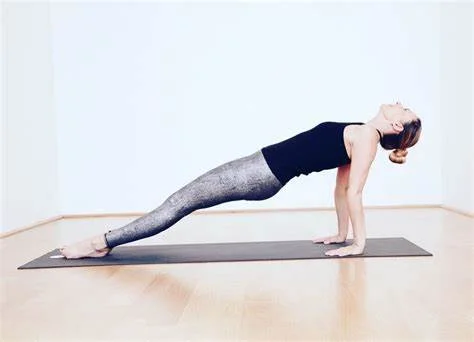
- From Bridge Pose, you can leave or eliminate the block between the thighs. Lower the hips to the floor, then rise to sit. Position the palms outside of your outer hips.
- Press your hands and feet together, then lift your hips as well as your torso. Your shoulders will be stacked above your wrists.
- Straighten your arms. Keep pressing down on your feet, via your body weight to activate your hamstrings.
- Extend your sitting bones to the supports of your knees, and keep the inside of your thighs releasing downward.
- Expand your torso evenly. You may maintain your knees bent straighten them and point your toes. tuck your chin slightly in toward your chest, or extend the neck as your head drops back.
- Option: Straighten your legs as the four corners of your feet press down evenly. Keep the muscles in your thighs releasing downward. Maintain here for 5-10 breaths.
7. Upavistha Konasana (Wide-Angle Seated Forward Bend Variation).
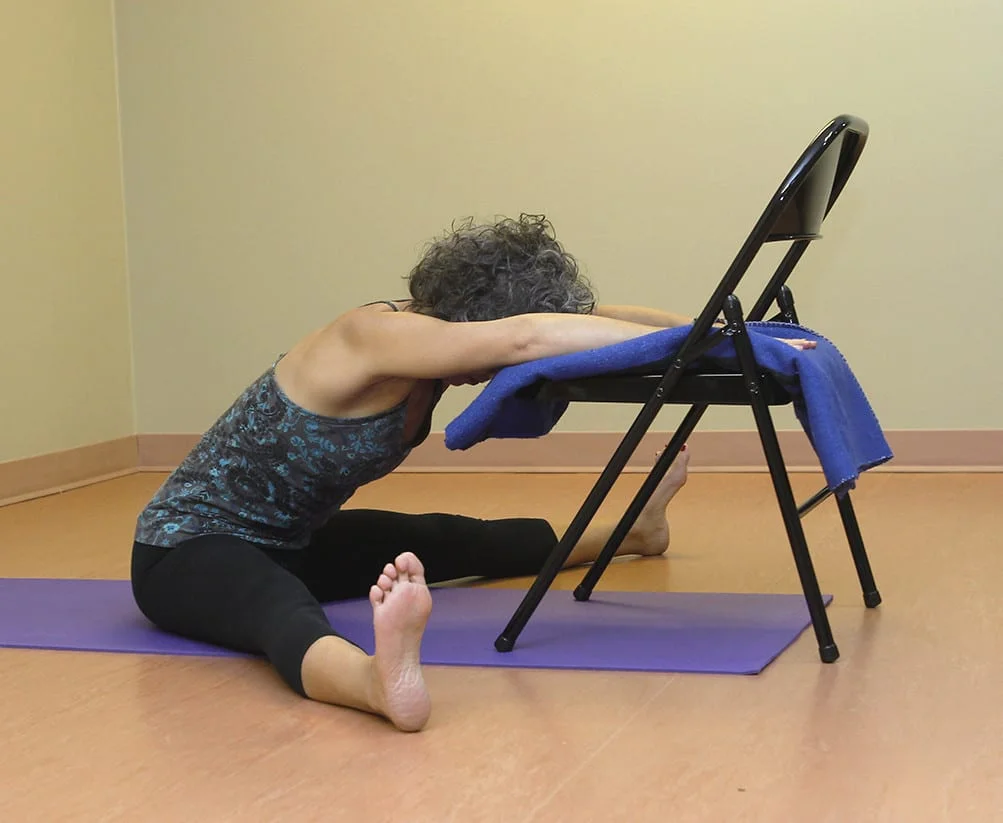
- A person demonstrates a Wide-Angled Seated Onward Bend with their arms as well as head resting on a chair.
- Attach a chair to the yoga mat you’re using. Sit on your mat with the chair’s seat facing you. Widen your legs so that you can straddle the chair.
- Place a blanket on the chair’s seat and hinge at the hips to lean forward, resting the arms on the blanket. They anchor your sitting bones to the floor. Allow your head to be heavy. Optional: Try this pose without the chair. If you want prop support, place a blanket as well as a bolster under your torso. Maintain here for 10-20 breaths.
8. Janu Sirsasana (Head of the Knee Pose)
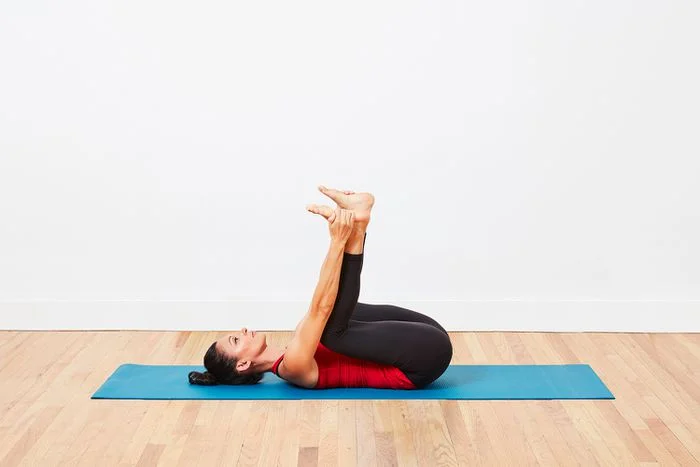
- Sit upright on a blanket and bolster. Extend your left leg straight ahead of you while bringing your right foot into the inside of your thigh or inner calf.
- Place a rolled-up blanket under your bent and straight knee to make the pose less intense.
- Wrap the yoga strap around you’re outstretched foot. Flex your foot and draw it towards your torso. If it is comfortable, lean upward toward your left foot. the experiment with releasing the strap while holding onto the leg muscle, ankle, or foot. Maintain here for 5-10 breaths.
- Repeat on the opposite side.
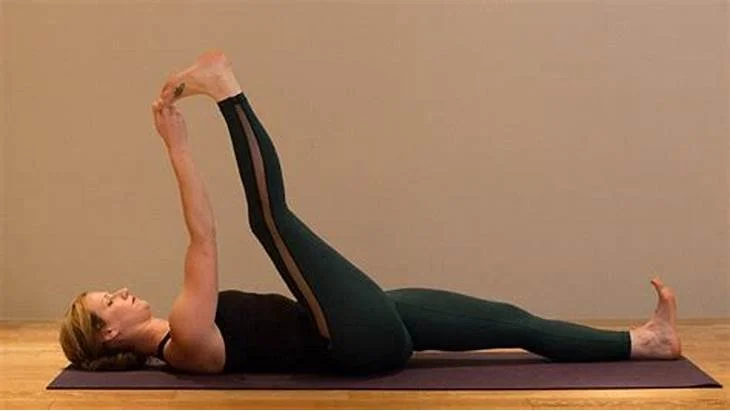
9. Reclined big toe pose (Supta Padangusthasana):
- Lie upon your back.
- Using a strap or belt, gently stretch the hamstrings by raising one leg to the ceiling.
- This pose is soft and accessible to most people.
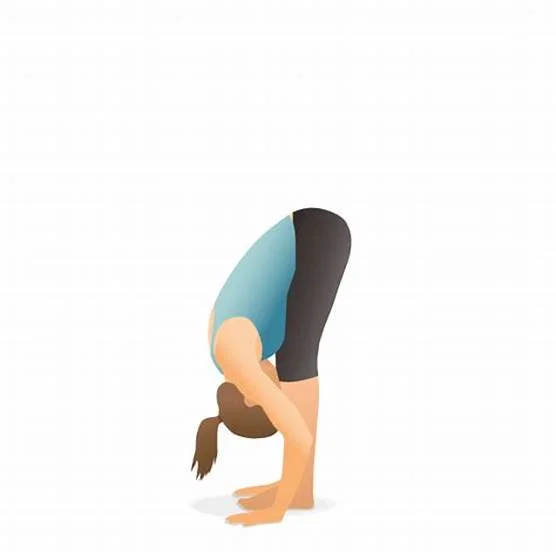
10. Standing forward bend (uttanasana):
- Move with your feet hip-width apart.
- Attach at your hips as well as fold forward, palms facing the ground or your shins.
- Gravity helps deepen the hamstring stretch during this pose.
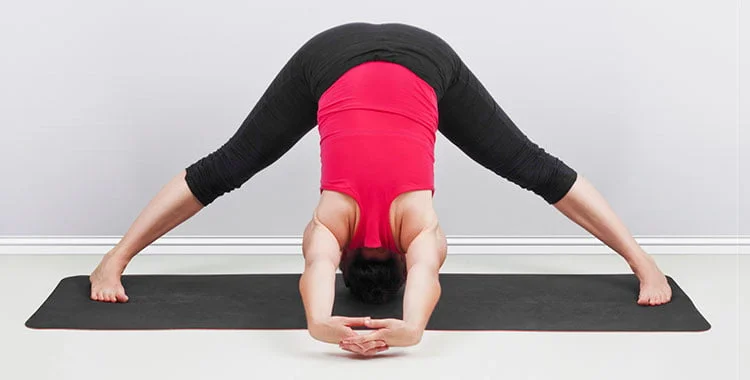
11. Standing Wide-Legged Forward Bend (Prasarita Padottanasana).
- stand with your feet wide apart.
- Fold forward, maintaining your spine straight and reaching your palms to the ground.
- This pose allows for a wider stretch in the hamstrings.
12. Downward Facing Dog (Adho Mukha Svanasana):
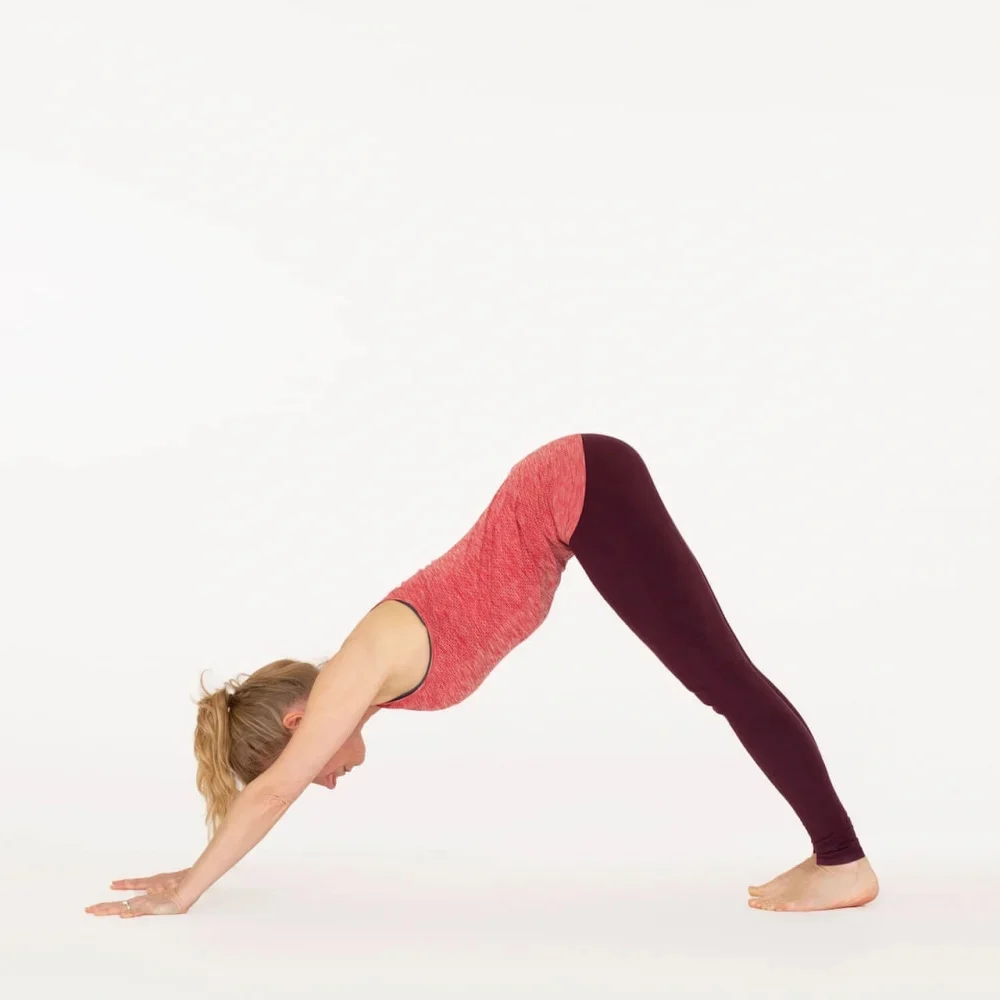
- Begin in a plank position.
- Lift the hips up and back to create an inverted V shape.
- To engage the hamstrings, press your heels toward the ground.
- If you’re unsure about your hand or foot placement, roll out briefly to Plank Pose, keeping your wrists under your shoulders as well as your hips lifted to approximately the same height as your shoulders. Then, lift your hips and get back into Down Dog. Lift the weight of your upper body and hips up and out of the wrists as you lower your heels to the ground.
Safety and Precautions during Yoga Pose for Hamstring Strengthening:
- Note that your heels might not touch, and you may need to bend the knees if your hamstrings are tight.
- Remember as well to start slowly, use props as needed, and maintain consistency in your practice. To prevent strain, gradually improve your hamstring flexibility.
- When performing yoga poses for hamstring stretching as well as strengthening, it is critical to prioritize safety and take the necessary precautions. Below are some guidelines to consider:
- Start Slowly: Begin with easy stretches and work up to advanced poses. Rushing to strong stretches can cause strain or injury.
- Listen to your body: Take note of how the body reacts in each pose. If you experience pain or discomfort, ease yourself and modify the stretch.
- Warm Up: Always warm up before stretching your hamstrings. A few minutes of gentle movement and dynamic stretches can help prepare your muscles.
- Use props: Props such as yoga straps, blocks, and folded blankets can help you achieve proper alignment and avoid overstretching.
- Avoid overstretching: Excessive stretching can cause hamstring strain. Target for a relaxed stretch without exceeding your limits.
- Engage core muscles.
- Activate the core to protect your lower back while performing forward bends as well as hamstring stretches.
FAQs
Is it good to stretch a tight hamstring?
While the benefits of stretching before and after exercise are unclear, stretching is beneficial to overall health because it improves flexibility and reduces the risk of injuries. Stretching the hamstrings can help keep them loose and flexible, thus enhancing posture, increasing flexibility, and preventing lower back pain.
When is the best time for stretching?
Warm up with 5 to 10 minutes of light walking, jogging, or biking. Even better, stretch after your workout while your muscles are warm. Consider not stretching before engaging in an intense activity, such as sprinting or track and field activities
Which hamstring is the strongest?
Physical principles show that the biceps femoris muscle exerts the most force compared to the other hamstring muscles: The implications to hamstring muscle strain injuries.
Do squats strengthen hamstrings?
Squats activate the hamstrings at about half the rate of stiff-legged deadlifts as well as hamstring curls. So, if you’re wondering which muscles squat work, keep in mind that the quads are primarily used, while the hamstrings are used infrequently.
Which of these exercises is best for strengthening your hamstrings?
The Top 5 Hamstring Exercises Everyone Should Try: Romanian Deadlifts. Jermaine recommends 3 to 4 sets of 8 to 12 reps, as long as you maintain proper form.
Exercises include Bulgarian Split Squats, Prone Leg Curls, Kettlebell Swings, and Good Mornings.
Which type of stretching increases flexibility?
Static stretching was an effective method to increase ROM.. The greatest change in ROM with a static stretch happens between 15 and 30 seconds; however, most authors believe that 10 to 30 seconds is adequate for increasing flexibility.
REFERENCES
- Eldridge, A. (2022, October 14). Hamstring | Definition, Function, Muscles, & Injury. Encyclopedia Britannica. https://www.britannica.com/topic/hamstring
- Lindberg, S. (1970, January 1). The 6 Best Stretches to Loosen Up Tight Hamstrings. https://www.onepeloton.com/blog/hamstring-stretches
- Cpt, K. D. M. R. (2022, February 21). Bodyweight Hamstring Exercises for Every Experience Level. Healthline. https://www.healthline.com/health/fitness/hamstring-exercises-bodyweight
- M. (2022, August 11). 12 Best Hamstring Bodyweight Exercises For Strength and Flexibility – Project Rise Fitness. Project Rise Fitness. https://www.projectrisefitness.com/best-hamstring-bodyweight-exercises/
- Hamstrings. (n.d.). Physiopedia. https://www.physio-pedia.com/Hamstrings
- Hamstring Muscles. (n.d.). https://www.columbiadoctors.org/health-library/article/hamstring-muscles/#tn7324-RelInfo
- Lindberg, S. (1970, January 1). The 6 Best Stretches to Loosen Up Tight Hamstrings. https://www.onepeloton.com/blog/hamstring-stretches
- Lindberg, S. (2022, September 20). 9 Best Hamstring Exercises for Stronger Legs. Verywell Fit. https://www.verywellfit.com/hamstring-exercises-for-stronger-legs-5094156
- Valand, B. (2022, October 4). Hamstring muscle exercises – Stretching & Strengthening workout. Samarpan Physiotherapy Clinic. https://samarpanphysioclinic.com/hamstring-muscle-exercises/
- Ryt, A. P. (2022, October 16). 20 Ways to Stretch Your Hamstrings With Yoga. Verywell Fit. https://www.verywellfit.com/yoga-poses-for-hamstrings-4045013
- Henderson, R. (2021, February 24). Practice These 10 Yoga Poses for Tight Hamstrings & to Gain Flexibility – YOGA PRACTICE. YOGA PRACTICE. https://yogapractice.com/yoga/10-yoga-poses-for-tight-hamstrings/
- Eske, J. (2024, January 19). What are the best stretches for tight hamstrings? https://www.medicalnewstoday.com/articles/323703#tips
- Pt, B. S. (2023, November 8). 6 Easy Hamstring Stretches to Do at Home. Verywell Fit. https://www.verywellfit.com/hamstring-stretches-2696359
- D. (2019, December 16). What is the Hamstring Exercise? 15 Best Hamstring Exercises for Stronger Legs. https://blog.decathlon.in/articles/best-hamstring-exercises
- McLean, S. (2024, February 14). 15 Best Hamstring Exercises & Workouts for Stronger Legs, DPT-Approved. BarBend. https://barbend.com/best-hamstring-exercises/

